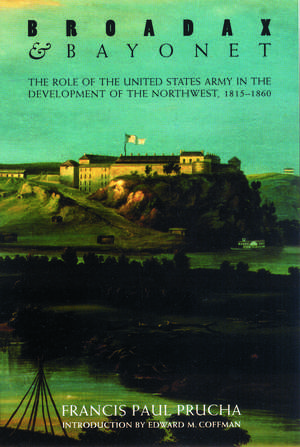Broadax and Bayonet: The Role of the United States Army in the Development of the Northwest, 1815-1860
Autor Francis Paul Prucha Introducere de Edward M. Coffmanen Limba Engleză Paperback – aug 1967
Preț: 100.83 lei
Nou
Puncte Express: 151
Preț estimativ în valută:
19.30€ • 20.97$ • 16.22£
19.30€ • 20.97$ • 16.22£
Carte disponibilă
Livrare economică 31 martie-14 aprilie
Preluare comenzi: 021 569.72.76
Specificații
ISBN-13: 9780803251519
ISBN-10: 0803251513
Pagini: 277
Ilustrații: Map
Dimensiuni: 140 x 216 x 15 mm
Greutate: 0.34 kg
Editura: BISON BOOKS
Colecția Bison Books
Locul publicării:United States
ISBN-10: 0803251513
Pagini: 277
Ilustrații: Map
Dimensiuni: 140 x 216 x 15 mm
Greutate: 0.34 kg
Editura: BISON BOOKS
Colecția Bison Books
Locul publicării:United States
Notă biografică
Known for his books about American Indian government policy and the frontier army, Francis Paul Prucha, S.J., is an emeritus professor of history at Marquette University
Introducing this edition is Edward M. Coffman, a professor of history at the University of Wisconsin, Madison, and the author of The Old Army: A Portrait of the American Army in Peacetime, 1784–1898.
Recenzii
"In a style that is clear, unhurried and . . . vigorous, Francis P. Prucha has written a definitive study of [the] frontier army that was itself a pioneer. It pushed the line of occupation far beyond settlements. It raised crops, herded cattle, cut timber, quarried stone, built sawmills and performed the manifold duties of pioneers. It restrained lawless traders, pursued fugitives, ejected squatters, maintained order during peace negotiations and guarded Indians who came to receive annuities."—New York Times Book Review
"A work of original research which stands almost alone in relating the Army’s work to the peaceful processes of territorial expansion and social development. Studying the thirteen army posts established in Wisconsin, Iowa, Minnesota, and northern Illinois, the author demonstrates their importance for Indian and land policy administration, as cash markets for the early settlers, and as centers of exploration, road-building, and cultural developments."—A Guide to the Study of the United States of America
"Well-written. . . . a significant contribution to the study of . . . both the westward movement and our military establishment."—Mississippi Valley Historical Review


























